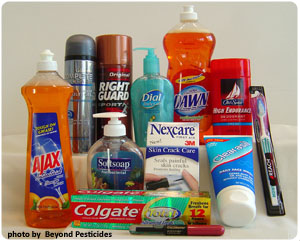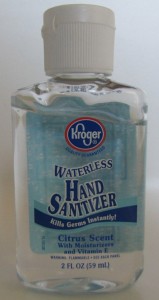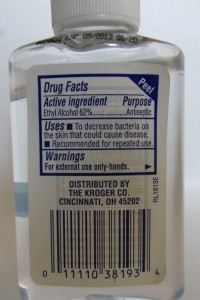What’s best–antibacterial soap, hand sanitizer, or just plain soap and water?
 We all want to keep our families and ourselves healthy, but, sometimes, what appears to be a good practice doesn’t really do the job. One type of product that doesn’t live up to its marketing is the wide range of antibacterial products–the triclosan- and alcohol-based hand sanitizers. They don’t appear to keep us healthier, and there could be significant health and environmental risks to their use, at least in the case of triclosan. Should we use them?
We all want to keep our families and ourselves healthy, but, sometimes, what appears to be a good practice doesn’t really do the job. One type of product that doesn’t live up to its marketing is the wide range of antibacterial products–the triclosan- and alcohol-based hand sanitizers. They don’t appear to keep us healthier, and there could be significant health and environmental risks to their use, at least in the case of triclosan. Should we use them?
What is triclosan?
Triclosan is a polychloro phenozy phenol antibacterial and antifungal ingredient in many consumer products, from hand and dish soaps to toothpaste, socks, and even children’s toys (See some of them in the photo from Beyond Pesticides, above). It has been used since 1972 in an ever-increasing number of products. Many orange-colored soaps and detergents, if labeled antibacterial, probably contain triclosan. Beyond Pesticides has a good list of products containing triclosan.
Is triclosan effective?
Unfortunately, triclosan is mostly a marketing success. It’s popularity “has been aided by the false public perception that antibacterial products are best to protect and safeguard against potential harmful bacteria.” However, triclosan doesn’t provide much help to kill bacteria or to keep us healthy. Many studies have found that using triclosan-based products is no more effective in removing bacteria, or viruses, than washing with plain soap and water. There is also no evidence that using antibacterial soaps prevents illness from colds, flu, skin infections, and gastrointestinal problems. “In laboratory studies, most people who washed their hands with triclosan-based hand soaps had no fewer bacteria on their hands that people who washed with plain soap and water.”
Even the FDA, which regulates triclosan-based over-the-counter drugs (including antimicrobial hand soaps, toothpastes, etc.), says there is no evidence that triclosan adds health benefits to consumer products, although they do not currently consider it hazardous to humans. The FDA does admit that more studies have been performed since their last analysis of triclosan and have agreed to review the new evidence. The EPA regulates the use of triclosan, as a pesticide, in a variety of materials such as fabrics, vinyl, plastics (toys, toothbrushes), textiles (footwear, clothing), caulking compounds, sealants, rubber, and carpeting. In 2008, the EPA assessed triclosan and found that it met then current safety standards; however, additional data now available has led the EPA to undertake “another comprehensive review of triclosan beginning in 2013.” Any change obviously won’t be made soon since they haven’t even begun the review.
Are there potential health and environmental risks from using triclosan?
Using triclosan-based consumer products is not only not effective for the advertised purpose–killing bacteria–studies have shown that there are some potentially serious effects on health and our environment. The EPA’s Office of Research and Development has found that the pesticide may be toxic to fish and aquatic plants and now requires industrial users of triclosan to “perform environmental modeling and surface water monitoring” and “add labeling statements indicating that triclosan is toxic to fish and other aquatic animals . . .” In addition, studies have linked triclosan to a variety of health and environmental problems, including “skin irritation, allergy susceptibility, bacterial, endocrine disruption and compounded antibiotic resistant, tainted water, and dioxin contamination to destruction of fragile aquatic ecosystems.”
A 2010 study suggests that “children with higher exposure to triclosan are more frequently diagnosed with allergies,” although the allergies may be related to the Hygiene Hypothesis rather that the toxicity of triclosan. Multiple animal studies have found links to thyroid hormone disruption. Triclosan may prevent use of normal thyroid hormones because it mimics them and binds to the hormone receptor sites, blocking use of the normal hormones.
Triclosan has been found in “both the bile of fish living downstream from waste-water-processing plants and in human milk.” Triclosan is also appearing in dolphins near South Carolina and Florida. Triclosan residues have been found in “sediment that was over 30 years old,” which suggests that it remains in the environment for a long time.
What about alcohol-based hand sanitizers?

 Alcohol-based hand sanitizers are frequently used when soap and water are not available. I carry a small bottle in my car as many of you probably do. Are they effective? Well, maybe. Research has shown that they do not “significantly reduce the overall amount of bacteria on the hands, and in some cases they may even increase it.” The manufacturers can claim 99.9% effectiveness because laboratory tests were made on inanimate surfaces very unlike human hands. An additional problem with these sanitizers is that alcohol just doesn’t cut through dirt and grime like soap and water. There are two ways to help increase effectiveness for hand sanitizers–when you just can’t find soap and water: (1) Use enough of it. CDC guidelines say that “If your hands are dry within 10 or 15 seconds . . . you haven’t used enough.” (2) The sanitizer “must have between 60 and 95% alcohols–ethyl, ethanol, isopropanol, etc.–less just isn’t enough.” My brand of sanitizer just barely makes the grade at 62%. Does yours?
Alcohol-based hand sanitizers are frequently used when soap and water are not available. I carry a small bottle in my car as many of you probably do. Are they effective? Well, maybe. Research has shown that they do not “significantly reduce the overall amount of bacteria on the hands, and in some cases they may even increase it.” The manufacturers can claim 99.9% effectiveness because laboratory tests were made on inanimate surfaces very unlike human hands. An additional problem with these sanitizers is that alcohol just doesn’t cut through dirt and grime like soap and water. There are two ways to help increase effectiveness for hand sanitizers–when you just can’t find soap and water: (1) Use enough of it. CDC guidelines say that “If your hands are dry within 10 or 15 seconds . . . you haven’t used enough.” (2) The sanitizer “must have between 60 and 95% alcohols–ethyl, ethanol, isopropanol, etc.–less just isn’t enough.” My brand of sanitizer just barely makes the grade at 62%. Does yours?
What can we do?
To reduce the possible health and environmental damage, we can try to avoid using triclosan wherever possible. It helps that the U.S. requires manufacturers to indicate on the label if the product contains triclosan. So, we need to read labels, not just for food, but for all the products we use. I’ll probably continue to use the alcohol-based hand sanitizer when I don’t have soap and water available, but I’ll try to use more of it. My hands were always dry right away, too quick to be effective, according to the studies.
Update July 2, 2012: I found this excellent post at the MommyPotamus: Hand Sanitizer Recalled For Containing Burkholderia Cepacia Bacteria.
Update March 11, 2013: Minnesota’s governor has issued an executive order that state agencies and institutions will no longer buy cleaning products that contain triclosan. It’s a step in the right direction. (source)
Sources:
Wikipedia: Triclosan
U.S. EPA: Triclosan Facts
U.S. FDA: Triclosan: What Consumers Should Know
Beyond Pesticides: Triclosan
Consumer Antibacterial Soaps: Effective or Just Risky”?
Environmental Working Group: Pesticide in Soap, Toothpaste and Breast Milk – Is It Kid-Safe?: Triclosan No Better Than Plain Soap
Are Anti-Bacterial Soaps Worth It?
Hand sanitizers no substitute for soap and water
Hand Sanitizers, Good or Bad?

Thanks for the information… For all the users it is important to check the label of antibacterial soap before purchasing…There is no point of using something that instead of giving any benefits harm your skin.